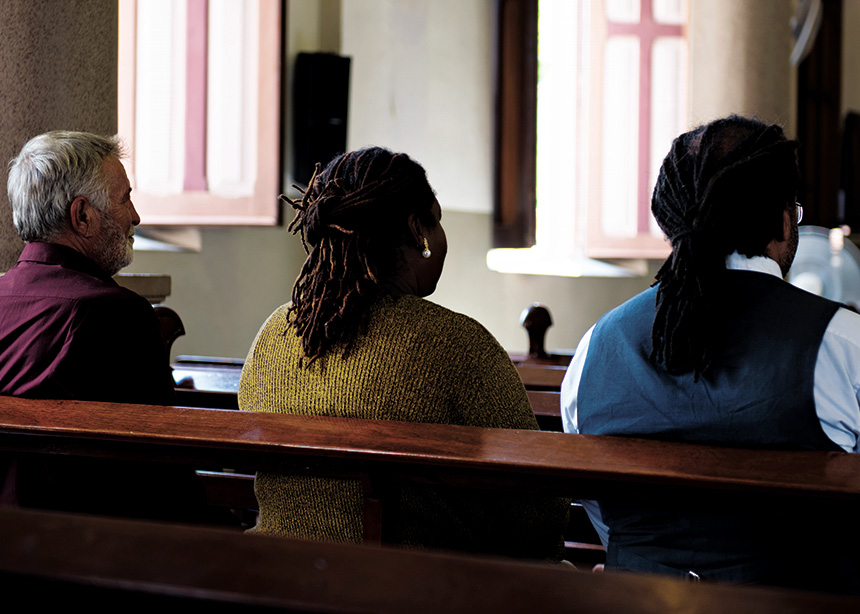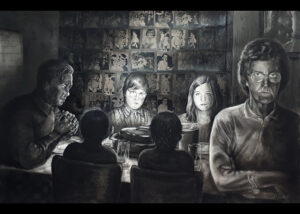He might be the youth leader, enthusiastically singing the loudest, or the young mother protectively watching over her children as they run among the pews, or the strong-willed divorcée who is the staunch activist for women’s justice, or the angry old man suffering from cancer while his wife sits quietly beside him. What they share is they are all survivors of childhood sexual abuse.
That abuser was likely not a stranger, not a person in power, and not a social authority figure. That abuser could have been a member of the family—a stepfather, a brother, an uncle, or a sister, an aunt, a grandmother, maybe even a father or mother. That abuser might have been a survivor of childhood sexual abuse at the hands of yet another family member.
Survivors of sexual abuse might routinely sit in the pews, they might be active in the church, or they might just drop in infrequently. But they are there. Often, their children are there and sometimes so are their friends, their partners and the people who care about them. It’s possible that their abusers are there, too.
Weekly, monthly or occasionally, sexual abuse survivors are part of congregational life. They do not advertise their suffering or background. They may not even have told their partners, and almost certainly are not public about their experiences. The only manifestations of their troubles might be emotional outbursts, deep anxiety about children, depression and anger; traits shared with many people who have not experienced childhood sexual abuse.
What brings survivors of sexual abuse to the church? When they come to me as a counsellor, they describe how they find in the church connections, community, stability, reframing values, ordered thinking and models of a better life. They are there to find a way to cope and to move forward. It’s not so much about their faith, which is often intense, as what faith can do for them that brings them. The following stories, all composites, share their experiences.
One person who no longer attends church activities has been clear that church life was a powerful place for him not to be a victim. He developed his competence and capacities as he helped in the youth group without the fear that haunted his home life. It wasn’t easy, but he became a respected member of the congregation, and that gave him the strength to leave home and the self-trust that he could live a new life.
Another explained how the beliefs and practices she found in church gave meaning and purpose to her life. She particularly appreciated the evangelicalism of the congregation, the strong belief perspectives and the constant outreach activities. She struggles with deep depression and regularly questions all her life and beliefs. But she comes back to life through the hard work of participation in congregational activities.
Another appreciates the perspective of hope and forgiveness that permeates the beliefs of the congregation. He resonates with the liturgy and finds the pastor a warm and caring resource.
Another person sits hidden and silent, protected by her husband’s presence. It is his family congregation, and in it she finds stability that masks the chaos in her own life.
What a congregation can do
For most congregations, sexual abuse in families is a hidden phenomenon. Pastors rarely know, and even close friends inside the church may be ignorant that it has happened in someone’s past. Yet probably every congregation has one or more sexual-abuse survivors in its midst.
Responding to this hidden reality of suffering is difficult. There are at least four things every congregation can do:
- Try to understand. Everyone needs to understand the prevalence of sexual, physical and emotional violence in families. These are multi-generational processes that are hard to break, as parents who suffered abuse in turn abuse their children or inadvertently create the conditions that lead to abuse.
It takes a great deal of work, good therapists and a supportive community to break the cycles. Blame doesn’t help, nor does a focus on “fixing” individuals. This is long-haul work that goes on all around us and in our congregations.
- Have good policies. Knowing that sexual abuse is prevalent, a congregation needs to have good safe-church policies that are well understood by adults and leaders in the congregation. There are legal requirements to report abuse that involves children. Plus, good policies create a calm framework, so people know what to do when cases of abuse are reported or when people become suspicious there are serious problems.
When everyone knows whom to talk to, and what resources the congregation can supply, effective action is possible.
- Provide confidential support. Sexual abuse typically carries with it a great deal of shame and guilt. People usually don’t voluntarily disclose this type of experience; it might come out in pastoral or close community relationships. Then it is helpful to know that the church community can provide confidential support. This support might require a commitment that lasts for years, since this type of experience is not easily resolved. A congregation might want to offer survivors a counselling scholarship or subsidy as well.
- Remain faithful as a community in Christ. An important experience for one recovering from sexual abuse is the acceptance of a community in pursuit of the gospel.
What individuals can do as part of a faithful community
- Stay calm. A congregation that can stay calm in the face of any adversity, or change (and manages the change effectively), is one that both models emotional maturity and makes emotional maturity possible.
The survivors of abuse are hyper-sensitive to change, and when those around them are genuinely calm in the midst of stress, survivors can see the possibility of new routes for personal transformation. Or at least they can see the possibility of staying in one place long enough to build healing personal connections.
Conversely, when people in the congregation become highly emotional, the situation can create more problems for survivors. A highly emotional environment triggers destructive behaviours and intensifies their own emotional reactions. Congregations might find it difficult to stay calm when problems are real, but doing so is one of the most healing attributes of a Christian community.
- Be transparent. Gaslighting, twisting the facts, lying and false questioning—these are the norm in families where sexual abuse exists. For survivors, those behaviours lead to terrible confusion and mistrust of others.
Long-term trust can happen when there are open processes and transparent systems where the rules are easy to see, and trust leads to healing. When members of a congregation are open about their thinking and clear on the facts, the community models good emotional processes and helps assure those who are suffering anxiety feel that they are understood and safe.
- Be patient. Becoming highly emotional is the norm for abuse survivors. Slow church processes allow survivors to move past their initial reactions and get to a place of calm and acceptance. This allows them to improve their relationships and heal, even when circumstances require change.
Although this can be frustrating for many in a congregation, when it seems like decisions must be made, quick action only sets the stage for more problems for abuse survivors, as they feel abandoned. Opportunities for healing happen when congregations listen carefully, take time for slow processes and work at gentle decision-making.
- Be open about issues and problems. Avoidance of issues only creates more difficulties for survivors.
Their experiences have taught them not to trust and have made them hyper-sensitive to problems. They are used to denial and know that it leads to even more pain to come. When people in congregations try to be “nice,” and settle things behind closed doors, it only teaches the abused persons that their situation is dangerous.
Since, in everyday life, conflict is normal, to ensure those conflicts do not trigger reactions for abuse survivors, it is important to have open processes for managing them. Those processes, in and of themselves, model better ways for survivors to operate in their own lives.
- Make a place for all children. Perhaps the most healing thing a church can do is to include the children. When congregations ensure that children have an opportunity to find friends, express themselves and be part of a community, children can see what is possible for their own future.
With congregational acceptance, children can obtain the balance and connections that give them a chance to thrive, even when Mom or Dad is struggling. Add to that the babysitting, family befriending and social inclusion that can come from ordinary person-to-person relationships, and the number of healing opportunities multiplies.
You can be assured that the eyes of the children of abuse are carefully observing and trying to imitate the best in what they experience in their church.
Sexual abuse is all too common in our society. Its scars are everywhere, including among people in the church. But the congregational community, in its faithfulness, is one of the most powerful tools for changing that reality. By staying inclusive, calm and family-oriented, congregations help slowly, from generation to generation, to heal these terrible hurts.
Bruce Hiebert, Ph.D., is a former pastor and currently divides his time between teaching business ethics and working as a clinical counsellor. He can be reached at brucehiebert@shaw.ca.
For discussion
1. How does your congregation support participants who are suffering? Is this support public and organized, or mostly done privately? How do people in the congregation support each other on a regular basis? How well are children included in supportive networks?
2. Bruce Hiebert writes that survivors of abuse appreciate the church because it provides “connections, community, stability, reframing values, ordered thinking and models of a better life.” What might be some examples of ways that a congregation can provide these things? How important are these character traits for everyone in the congregation?
3. Safe-church policies that are well-understood are important for a congregation, says Hiebert. Does your church have such a policy? What makes these policies so important?
4. Hiebert writes that it is important to stay calm, patient and to have a transparent process if there is an abuse issue. Why is it so important to proceed slowly and deliberately? What are the dangers of becoming highly emotional?
5. “[C]ongregational community in its faithfulness is one of the most powerful tools” for healing the scars of sexual abuse, says Hiebert. Do you find this idea heartening or daunting? How could your congregation strengthen its bonds of community?
—By Barb Draper








Leave a Reply
You must be logged in to post a comment.